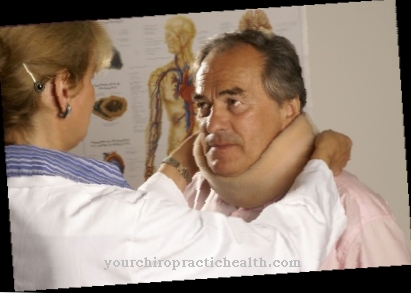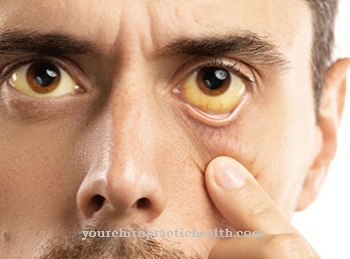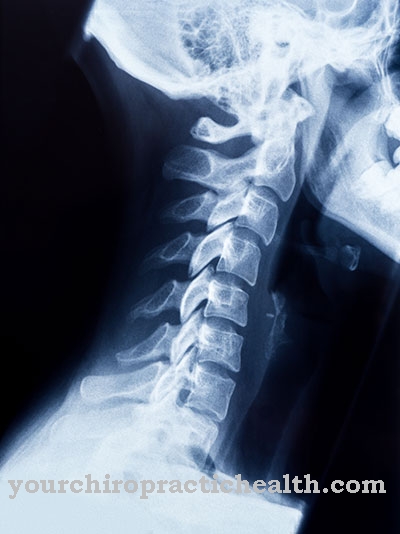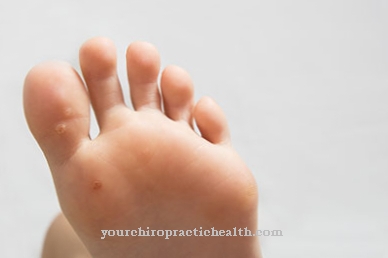At Circulatory disorders many people suffer from cold hands and feet. However, those affected are often not aware that this can hide serious illnesses. A visit to the doctor to clarify the cause is therefore sensible and advisable. Cold limbs are often a sign of arterial circulatory disorders, and these must always be treated by a specialist. A healthy blood flow to the organism is important in order to ensure a sufficient supply of oxygen to the organs. If the tissue is no longer supplied with sufficient blood and if this disease remains untreated, this can have serious consequences for humans.
What are circulatory disorders?

Schematic cross section of an artery. Clearly visible are the circulatory disorders caused by plaque (deposits) (yellow) and the red blood cells. Click to enlarge.
From a medical point of view, circulatory disorders mean a reduced supply of various parts of the body and organs with nutrient-rich and oxygen-rich blood. Mostly as a result of narrowing or clogging of the arteries. With increasing age, the risk of developing circulatory disorders increases. However, recent studies have shown that younger patients are also increasingly affected by this disease.
A characteristic of all types of circulatory disorders is the fact that the person affected feels little or no discomfort in the early stages. The disease only becomes noticeable when the blood flow is already more severely impaired. Since circulatory disorders can cause life-threatening situations such as a stroke or heart attack, preventive measures are of great importance.
causes
The causes of circulatory disorders are manifold and can have different origins. The most common, however, are arteriosclerosis (narrowing or occlusion of arteries due to deposits), blood clots in the body (thrombi or embolism) or vascular inflammation. However, a too high cholesterol level, obesity, diabetes mellitus, low blood pressure, smoking or lack of exercise also increase the risk of developing circulatory disorders.
Since hardening of the arteries (arteriosclerosis) is the most common cause of circulatory disorders, it should be described briefly in more detail. In arteriosclerosis, age, an unhealthy lifestyle and an unhealthy diet lead to deposits and wear and tear on the blood vessels. As a result, the arteries narrow so much that hardly any blood can flow through them.
One can speak of a downright blockage of the blood vessels or of blood congestion. This explains the circulatory disorders, which are then responsible for the following typical complaints and symptoms.
Symptoms, ailments & signs
Circulatory disorders can manifest themselves through very different symptoms. The signs and symptoms that occur depend on the location and extent of the circulatory disorders. In the case of an acute vascular occlusion in the arm or leg arteries, intense pain occurs in the affected limb within a short time.
There are usually six symptoms: loss of pulse, pain, paleness and cold, sensory disorders, muscle weakness and shock. Depending on the severity of the circulatory disorder, these symptoms can last a few seconds to minutes and sometimes cause serious complications. With peripheral arterial disease, the symptoms tend to develop insidiously.
They occur in four stages. In the first stage there are no symptoms at first, but the person affected often feels a slight tingling or stinging sensation in the limbs. In the second stage, pain increasingly occurs, which is particularly noticeable when walking and other physical strains.
In the third stage, the symptoms also appear at rest. In the fourth stage, a circulatory disorder manifests itself through persistent pain, and tissue damage such as the smoker's leg also occurs. Chronic circulatory disorders almost always affect both legs, but they can vary in severity. The affected limb often appears less sensitive to touch.
course
Depending on which arteries are affected, circulatory disorders can occur in different parts of the body or organs. Most often, the disease occurs in the brain, heart or extremities (especially in the legs, sometimes in the arms). With circulatory disorders in the heart, the patient feels pain and a feeling of tightness in the chest area, often combined with the feeling of not being able to breathe properly (angina pectoris). In milder cases, these complaints only come to light with physical exertion.
If the brain, or at least parts of it, is no longer supplied with enough oxygen, numbness in the arms and legs can occur. Difficulty speaking (symptomatic: sudden drooping of the corner of the mouth), visual disturbances, ringing in the ears or dizziness can also be signs of a circulatory disorder in the brain, often linked to disorientation and confusion on the part of the person concerned.
Feelings of coldness in the feet, pain and tingling or even numbness in the legs can indicate circulatory disorders in the legs. But also sleep disorders due to pain and cramps or even skin discoloration (as a result of tissue death) are serious indications.
Complications
A disturbed blood flow can cause various complications. In the case of acute circulatory disorders, sensory disorders occur in the limbs within a few minutes. Most of the time, paralysis occurs and pronounced muscle weakness occurs. If the blood flow does not return to normal, circulatory shock and death of the patient can ultimately occur.
Circulatory disorders in the context of chronic arterial occlusive disease cause serious complications when going through the stages of the disease. Already in the second stage there is pain during physical exertion. In the third stage, the pain also occurs in phases of rest and is accompanied by feelings of pressure in the legs.
In the fourth stage, tissue damage and eventually the formation of a smoker's leg can occur. Impaired blood circulation in the fingers can lead to the death of the limbs and, in the long term, cause various diseases such as progressive systemic scleroderma.
Circulatory disorders in the intestine can lead to a deterioration in the general condition, shock and ultimately to life-threatening arterial obstruction. This can lead to intestinal paralysis and the death of intestinal tissue. If the circulatory disorders of the heart muscle are not treated, there is a risk of a heart attack.
When should you go to the doctor?
The first signs of a circulatory disorder should be clarified by a doctor. If you suddenly feel numb in your legs or pain while walking, this suggests a serious cause that needs to be investigated and, if necessary, treated immediately. Other warning signs include difficulty speaking, impaired vision, memory disorders (e.g. forgetfulness) and feelings of tightness in the chest.
Anyone who notices one or more of these symptoms should see a doctor immediately. Patients with high blood pressure, overweight or high blood lipid levels should consult their doctor regularly. At the first signs of a circulatory disorder, a doctor must be consulted and appropriate therapy initiated in order to minimize the risk factors. The same applies to people who suffer from diabetes mellitus, generally have an unhealthy diet or are smokers.
These risk groups should pay particular attention to possible warning signs from their body and prevent further complaints through rapid treatment. Cardiovascular problems such as dizziness, eye flickering or sweating are a medical emergency. The person affected or the first aider should immediately alert an ambulance service or go to the nearest hospital. In the event of a circulatory collapse or a stroke, first aid measures must be provided.
Doctors & therapists in your area
Treatment & Therapy
Basically: circulatory disorders and cardiovascular diseases can be prevented by a healthy lifestyle. This includes a wholesome, alkaline diet, avoiding nicotine, alcohol and caffeine (or at least a moderate consumption of these stimulants), enough exercise in the fresh air and weight control. But a balanced lifestyle can also be seen as an important prevention factor.
However, once the disease has occurred, self-help is no longer possible, or only to a limited extent under medical supervision. It is therefore essential to see a doctor. In the treatment of circulatory disorders, a distinction is made between acute complaints, which are considered medical emergencies (stroke, heart attack, acute occlusion of the leg artery, etc.) and long-standing complaints that are treated by changing lifestyle, medication and other medical treatments.
In addition to preventive measures to maintain and promote health, it is advisable to have regular check-ups carried out by a doctor. In this way, circulatory disorders can also be detected early and serious secondary diseases can be prevented.
Outlook & forecast
The prognosis of circulatory disorders is individual and results from various factors. It depends on the localization of the disturbance and its extent. In addition, the underlying disease is largely responsible for the further course and the chances of recovery.
If the body is incorrectly posture, blood congestion often occurs. This form of circulatory disturbance usually disappears completely within a few minutes. By changing the posture as well as compensating movements, the blood flow is stimulated again until the interruption has been resolved. In these cases, the organism regenerates itself.
Damage to the vessel walls may not be healed. With arteriosclerosis, the prognosis is unfavorable because there is no regression. If the circulatory disorders cannot be stopped, secondary diseases will occur. In the most severe cases, the patient suddenly suffers an acute health condition. A heart attack or a stroke is caused by the disturbance in blood flow. An ambulance service is needed, as it can be fatal or life-long impairments occur.
The disturbances represent an immense burden on the cardiovascular system. The heart muscles are heavily used and can become ill. In some cases of circulatory disorders in the extremities, treatment consists of amputation of the affected area.
Aftercare
Regular follow-up checks should be carried out by the attending physician. This includes regular ultrasound examinations of the blood vessels. This means that the further progression of the circulatory disorders can be monitored or identified at an early stage. If necessary, treatment could then start promptly and, if necessary, prevent a worse course.
If the impairment due to the circulatory disorder persists, the rehabilitation measures that have been started should also be continued at home. In coping with everyday life, the relatives and those affected must learn to cope with the new situation. More exercise is a means of promoting Genesun. Thus, the blood circulation is promoted in a natural way.
No strenuous strength exercises in the fitness center are necessary. Even simple exercises such as walking, cycling, hiking and swimming improve blood circulation. These activities should be agreed with the attending physician in advance.
Whether home remedies are useful for the follow-up treatment of circulatory disorders is essential to discuss with the doctor, also with regard to possible interactions with medication that has already been taken. Garlic thus enormously promotes blood circulation. The healthy vessels remain elastic.
The hawthorn is also verifiably confirmed that it contributes to strengthening and cleaning the veins and also ensures better blood circulation. Massages with circulatory oils or tinctures can also help relieve the blood vessels.
You can do that yourself
In the case of an existing circulatory disorder, those affected can take some measures themselves to alleviate the symptoms. As soon as you get up, gymnastic exercises such as the foot seesaw help to crank the vein pump.
Cold showers, starting and ending with a cold shower, also stimulate blood circulation. A reduced form would be cold pours over the lower legs or forearms as they are also used in the Kneipp treatment. This can be supplemented by a subsequent brush massage.
This also promotes the detoxification process. Drinking a glass of warm water - supplemented with slices of ginger at will - after getting up has also proven beneficial. This practice comes from the Indian art of healing Ayurveda and stimulates the flow of body fluids, including the bloodstream.
In order to reduce circulatory disorders or to prevent aggravation, you should exercise regularly. Stronger muscles help the veins to transport blood against gravity. Endurance sport also strengthens the cardiovascular system. Furthermore, all measures that contribute to a healthier life help: little alcohol and fatty foods, but varied and vital substance-rich food with a high proportion of vegetables.
Horseradish also stimulates blood circulation. The connection between circulatory disorders and mental health was also confirmed. Therefore, relaxation methods are also an option for self-treatment. Nevertheless, the family doctor should be consulted in the event of permanent complaints.



























